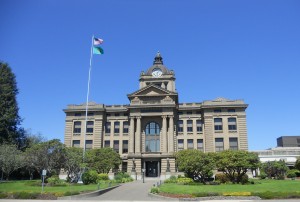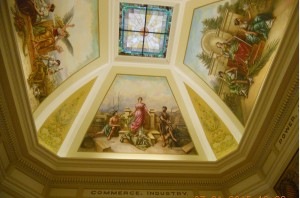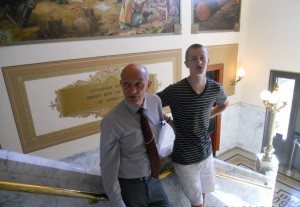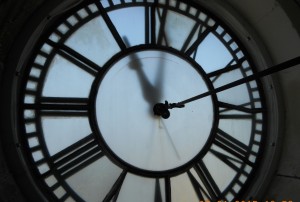By Kristine Lowder
![]() You never know what you’ll find inside an oyster, but a little prying can reveal a pearl. The same goes for the Grays Harbor County Courthouse in Montesano.
You never know what you’ll find inside an oyster, but a little prying can reveal a pearl. The same goes for the Grays Harbor County Courthouse in Montesano.
Considered one of the state’s finest, the courthouse was built in 1911 for $193,470.84. An eclectic blend of history, architecture and art, its story starts before Montesano became the county seat.

Grays Harbor’s governmental hub was originally located south of the Chehalis River in the home of the county’s first white settlers, Isaiah and Lorinda Scammon. Montesano was incorporated in 1883. Three years later, county government was ready to move out of Lorinda’s parlor, and Montesano and Cosmopolis duked it out for the next courthouse site.
The question was put to voters. Montesano, “The Maid of Wynoochee,” won. Courthouse construction began in 1889, but the burgeoning county soon outgrew the original wooden structure. A new courthouse was needed, and the good people of Chehalis County got busy.
Then known as the Chehalis County Courthouse, the original cornerstone for the current county courthouse was laid in spring of 1909. The groundbreaking ceremony was a momentous occasion, complete with live music from the Montesano High School band.
Architect Watson Vernon of Aberdeen envisioned a massive stone Temple of Justice-type building with arched windows and classical columns, crowned by a stately dome. It’s evident that no shortcuts were made when it came to the construction of the ornate structure.
Complete with brass rails, marble sheathing, varnished walnut and oak panels, terrazzo and ceramic tile floors, and beveled glass windows, the courthouse is spit-and-polish from floor to ceiling. Even the floors have a history.

County Commissioner, Frank Gordon, explains that ships from Alaska unloaded in Grays Harbor and used granite for ballast. Some of that granite made its way into the terrazzo flooring. He adds, “The center stairway came after the building was built. It used to be a side stairway. The original lighting was gas. Electricity didn’t come through till later.”
Above foot level, the stained glass ceiling atop the rotunda is surrounded by four murals created by Associated Artists of Milwaukee. The murals depict scenes of science, thought art, power, justice, truth, commerce, industry, agriculture, abundance and domesticity. Colorful murals also hug the walls of the original foyer.
One of the murals, painted by German artist Franz Rohrbeck, portrays s Territorial Governor Isaac Stevens signing a treaty with Canoe Indian tribes at Cosmopolis in 1855. The 9- by 11-foot painting was transported from Milwaukee and glued to the plaster stairway wall.
Opposite the Rohrbeck painting, a mural by Swiss artist Franz Biberstein depicts Captain Robert Gray’s 1792 arrival. (Both murals are historically inaccurate, depicting the Native Americans as Plains Indians, not Coastal Indians. The work was completely restored by a team of three specialists from Seattle in 1986.)
The second floor houses Superior Courtrooms. A mural in the west courtroom is Gordon’s favorite. Titled “Instruction,” it depicts a woman teaching a child. The woman had four toes in the original. “They gave her five toes when she was sent down for restoration,” explains Gordon. “I like it because it has the child and toes added. It’s original and unique.”

The west courtroom also features a portrait of Judge Mason Irwin, the first judge in Chehalis County. According to Gordon, “They found this picture under the building [during post-earthquake upgrades]. It was all dark and moldy and they restored it. It’s the only known photo of the judge.”
The woodwork on the jury box is also original. “It’s amazing what they could do with the tools they had back then” says Gordon. “Think of the labor and skill required at that time.”
And time hasn’t always been kind to the courthouse. The building sustained significant damage when a 5.1 earthquake rocked Grays Harbor County on July 2, 1999. “We almost lost the building after the earthquake,” says Gordon. “It was built without rebar. Lots of the building is sandstone.”
“The whole clock tower was dislodged,” recalls Public Services Director, Kevin Varness. “Now we have new, black steel in the clock tower and other seismic improvements.”
The ceiling paintings were also damaged in the quake. “They were stuck to the canvas with beeswax,” says Gordon. “They peeled them off, shipped them to California, restored them and put them back.”
Varness adds that mural restoration was also performed in Seattle and Portland. Local labor was also used. “The stained glass in the clock tower was redone by a lady in Hoquiam who’s a glass artist,” he says.
Restoration efforts took about two years and cost about $7.2 million. “After the initial temporary restoring, people moved back in” explains Varness. “People were up on scaffolds in 2001 when the Nisqually earthquake hit. The building did really well,” he says happily. “We were fortunate that we completed our seismic upgrades and had a reinforced building.”

The building is now up to code, and it was officially re-dedicated on July 28, 2001. Metal detectors and additional security were added in 2012.
Over the years, the courthouse has played host to several headline-grabbing trials including the 1910 murder trial of the infamous Billy Gohl, the “Centralia Massacre” case of 1920, and also the case of Italian-born Guido Grassi, who heard himself sentenced to hang twice, once in 1924 and again in 1958.
From the noteworthy architecture and detail of the building — which includes its more than 100-year-old E. Howard clock — to the newsworthy trials that have taken place behind the courthouse’s walls, the Grays Harbor County Courthouse is rich with history. “[The courthouse] is an asset of historical significance,” says Gordon, and Varness agrees. “I’ve got such an attachment to the building. There’s such a lot of history there,” he says.
The Grays Harbor County Courthouse is located at 102 West Broadway in Montesano. Hours are 9:00 a.m. to 5:00 p.m. Monday through Friday. Admission is free. Visitors are free to walk throughout the courthouse. Please keep in mind that court may be in session. Special permission is needed to climb the clock tower. For more information, contact the Grays Harbor County Courthouse at 360-249-3731.











































